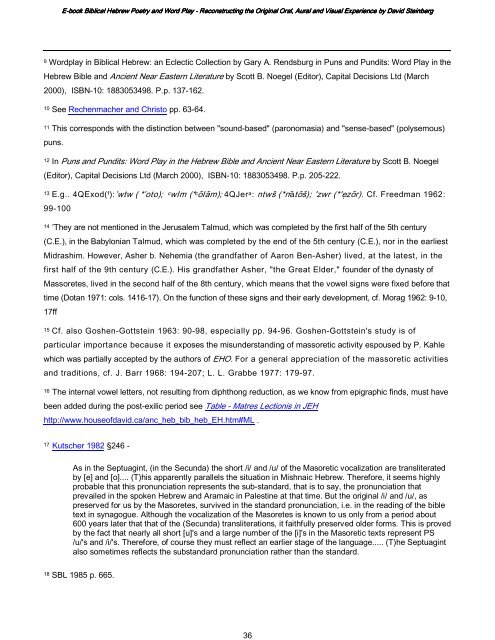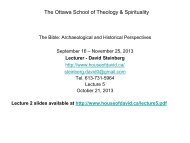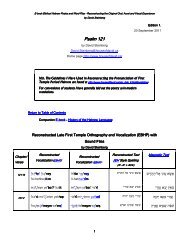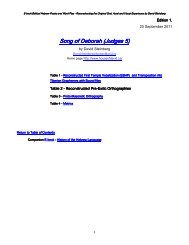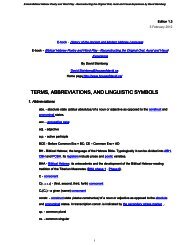Biblical Hebrew Poetry - House of David Steinberg
Biblical Hebrew Poetry - House of David Steinberg
Biblical Hebrew Poetry - House of David Steinberg
Create successful ePaper yourself
Turn your PDF publications into a flip-book with our unique Google optimized e-Paper software.
36<br />
E-book<br />
<strong>Biblical</strong> <strong>Hebrew</strong> <strong>Poetry</strong> and Word Play - Reconstructing the Original Oral, Aural and Visual Experience by <strong>David</strong> <strong>Steinberg</strong><br />
9 Wordplay in <strong>Biblical</strong> <strong>Hebrew</strong>: an Eclectic Collection by Gary A. Rendsburg in Puns and Pundits: Word Play in the<br />
<strong>Hebrew</strong> Bible and Ancient Near Eastern Literature by Scott B. Noegel (Editor), Capital Decisions Ltd (March<br />
2000), ISBN-10: 1883053498. P.p. 137-162.<br />
10 See Rechenmacher and Christo pp. 63-64.<br />
11 This corresponds with the distinction between "sound-based" (paronomasia) and "sense-based" (polysemous)<br />
puns.<br />
12 In Puns and Pundits: Word Play in the <strong>Hebrew</strong> Bible and Ancient Near Eastern Literature by Scott B. Noegel<br />
(Editor), Capital Decisions Ltd (March 2000), ISBN-10: 1883053498. P.p. 205-222.<br />
13 E.g.. 4QExod( f ):’wtw ( *’oto); c wIm (* c ōIām); 4QJer a : ntwš (*nātōš); 'zwr (*'ẹzōr). Cf. Freedman 1962:<br />
99-100<br />
14 '' They are not mentioned in the Jerusalem Talmud, which was completed by the first half <strong>of</strong> the 5th century<br />
(C.E.), in the Babylonian Talmud, which was completed by the end <strong>of</strong> the 5th century (C.E.), nor in the earliest<br />
Midrashim. However, Asher b. Nehemia (the grandfather <strong>of</strong> Aaron Ben-Asher) lived, at the latest, in the<br />
first half <strong>of</strong> the 9th century (C.E.). His grandfather Asher, "the Great Elder," founder <strong>of</strong> the dynasty <strong>of</strong><br />
Massoretes, lived in the second half <strong>of</strong> the 8th century, which means that the vowel signs were fixed before that<br />
time (Dotan 1971: cols. 1416-17). On the function <strong>of</strong> these signs and their early development, cf. Morag 1962: 9-10,<br />
17ff<br />
15 Cf. also Goshen-Gottstein 1963: 90-98, especially pp. 94-96. Goshen-Gottstein's study is <strong>of</strong><br />
particular importance because it exposes the misunderstanding <strong>of</strong> massoretic activity espoused by P. Kahle<br />
which was partially accepted by the authors <strong>of</strong> EHO. For a general appreciation <strong>of</strong> the massoretic activities<br />
and traditions, cf. J. Barr 1968: 194-207; L. L. Grabbe 1977: 179-97.<br />
16 The internal vowel letters, not resulting from diphthong reduction, as we know from epigraphic finds, must have<br />
been added during the post-exilic period see Table - Matres Lectionis in JEH<br />
http://www.house<strong>of</strong>david.ca/anc_heb_bib_heb_EH.htm#ML .<br />
17 Kutscher 1982 §246 -<br />
As in the Septuagint, (in the Secunda) the short /i/ and /u/ <strong>of</strong> the Masoretic vocalization are transliterated<br />
by [e] and [o].... (T)his apparently parallels the situation in Mishnaic <strong>Hebrew</strong>. Therefore, it seems highly<br />
probable that this pronunciation represents the sub-standard, that is to say, the pronunciation that<br />
prevailed in the spoken <strong>Hebrew</strong> and Aramaic in Palestine at that time. But the original /i/ and /u/, as<br />
preserved for us by the Masoretes, survived in the standard pronunciation, i.e. in the reading <strong>of</strong> the bible<br />
text in synagogue. Although the vocalization <strong>of</strong> the Masoretes is known to us only from a period about<br />
600 years later that that <strong>of</strong> the (Secunda) transliterations, it faithfully preserved older forms. This is proved<br />
by the fact that nearly all short [u]'s and a large number <strong>of</strong> the [i]'s in the Masoretic texts represent PS<br />
/u/'s and /i/'s. Therefore, <strong>of</strong> course they must reflect an earlier stage <strong>of</strong> the language..... (T)he Septuagint<br />
also sometimes reflects the substandard pronunciation rather than the standard.<br />
18 SBL 1985 p. 665.


